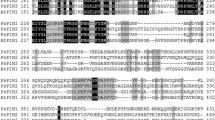Abstract
N-1-naphthylphthalamic acid (NPA), an auxin transport inhibitor, was found to bind specifically to a crude membrane preparation from sugar beet seedling leaf cell suspension cultures. The dissociation constant (Kd) and binding protein concentration were found to be 1.71 μmol dm−3 and 220 pmol g−1(membrane protein), respectively. The amount of specific 3H-NPA binding was significantly increased by adding Mg2+ATP to the binding assay solution. Treatment of membrane preparations with acid phosphatase, prior to the NPA binding assay, resulted in lower specific binding. ATP activation and phosphatase inactivation were culture stage dependent. Although a considerable effect could be detected when using cells from day 8 (representing the linear phase), the same treatment did not alter the binding if cells from day 1 (representing lag phase) or day 14 (representing the stationary phase) were used. These observations have strongly highlighted the possible involvement of a phosphorylation and dephosphorylation mechanism in vivo in the regulation of the activity of the NPA binding protein. High phosphatase activity was found in the supernatant, but not in the membrane pellet) after 50 000 g centrifugation. Our present study has indicated that receptor activity could be regulated by a phosphorylation and dephosphorylation mechanism in plants.
Similar content being viewed by others
References
Bradford, M.: A rapid and sensitive method for the quantitation of microgram quantities of protein utilizing the principle of protein-dye binding.-Anal. Biochem. 72: 248–254. 1976.
Cadena, D.L., Cha, C.L., Gill G.N.: The intracellular tyrosine kinase domain of the epidermal growth factor receptor undergoes a conformational change upon autophosphorylation.-J. biol. Chem. 269: 260–265. 1994.
DeLong, A., Mockaitis, K., Christensen, S.: Protein phosphorylation in the delivery of and response to auxin signals.-Plant mol. Biol. 49: 285–303, 2002.
Deruere, J., Jackson, K., Garbers, C., Soll, D., DeLong, A.: The RCNV-encoded A subunit of protein phosphatase 2A increases phosphatase activity in vivo.- Plant J. 20: 389–399, 1999.
Dixon, R.A. (ed.): Plant Cell Culture: A Practical Approach.-IRL Press, London 1985.
Elliott, M.C., Hall, J.F., Xing, T., O'Sullivan, A.M., Scott, N.W., Barker, R.D.J.: The role of IAA in the regulation of plant cell division.-In: Bandurski, R.S., Kutacek, M., Krekule, J. (ed.): Physiology and Biochemistry of Auxins in Plants. Pp. 152–157. Academia, Prague 1988.
Elliott, M.C., Xing, T., Hall, J.F., O'Sullivan, A.M., Barker, R.D.J.: The regulation of IAA levels in plant cells in suspension culture.-In: Kutáček. M., Elliott, M.C., MachaCkov, I. (ed.): Molecular Aspects of Regulation of Plant Development. Pp. 125–135. SPB Academic Publishing, The Hague 1990.
Fowler, M.R., Eyre, S., Scott, N.W., Slater, A., Elliott, M.C.: The plant cell cycle in context.-Mol. Biotechnol. 10: 123–153, 1998.
Gälweiler, L., Guan, C., Müller, A., Wisman, E., Mendgen, K., Yephremov, A., Palme, K.: Regulation of polar auxin transport by AtPINI in Arabidopsis vascular tissue.-Science 282: 2226–2230, 1998.
Garbers, C., DeLong, A., Deruere, J., Bernasconi, P., Soll, D.: A mutation in protein phosphatase 2A regulatory subunit affects auxin transport in Arabidopsis.- EMBO J. 15: 2115–2124, 1996.
Hardie, D.G.: Plant protein serine/threonine kinases: classification and functions.-Annu. Rev. Plant Physiol. Plant mol. Biol. 50: 97–131. 1999.
Krupnick, J.G., Benovic, J.L.: The role of receptor kinases and arrestins in G protein-coupled receptor regulation.-Annu. Rev. Pharmacol. Toxicol. 38: 289–319. 1998.
Luschnig, C: Auxin transport: ABC proteins join the club.-Trends Plant Sci. 7: 329–332. 2002.
Muday, G.K., DeLong, A.: Polar auxin transport: controlling where and how much.-Trends Plant Sci. 6: 535–542. 2001.
Palme, K., Galweiler, L.: PIN-pointing the molecular basis of auxin transport.-Curr. Opinion Plant Biol. 2: 375–381, 1999.
Rashotte, A., DeLong, A., Muday, G.K.: Genetic and chemical reductions in protein phosphatase activity alter auxin transport, gravity response. and lateral root growth.-Plant Cell 13: 1683–1697, 2001.
Rubery, P.H., Sheldrake, A.R.: Carrier-mediated auxin transport.-Planta 118: 101–121, 1974.
Ruegger, M., Dewey, E., Hobbie, L., Brown, D., Bernasconi, P., Turner, J., Muday G., Estelle, M.: Reduced naphthylphthalamic acid binding in the tir3 mutant of,4rabidopsis is associated with a reduction of polar auxin transport and diverse morphological defects.-Plant Cell 9: 745–757, 1997.
Scatchard, G.: The attraction of proteins forms small molecules and ions.-Ann. N.Y. Acad. Sci. 57: 660–672. 1949.
Sibley, D.R., Benovic, I.L., Caron, M.G., Lefkowitz, RJ.: Regulation of transmembrane signaling by receptor phosphorylation.-Cell 48: 913–922, 1987.
Sussman, M.R., Gardner, G.: Solubilization of the receptor for Nl-naphthylphthalamic acid.-Plant Physiol. 66: 1074–1078, 1980.
Xing, T., Hall, J.F., Barker, R.D.J., Elliott, M.C.: The importance of sulphydryl groups in the maintenance of the activity of N-1-naphthylphthalamic acid binding proteins in A4cer pseudoplatanus L. cells.-Biol. Plant. 38: 47–51. 1996.
Xing, T., Higgins, V.J., Blumwald, E.: Race-specific elicitors of Cladosporium fulvumn promote translocation of cytosolic components of NADPH oxidase to the plasma membrane of tomato cells.-Plant Cell 9: 249–259, 1997.
Xing, T., Wang, X.J., Malik, K., Mik, B.L.: Ectopic expression of an Arabidospsis CDPK enhanced NADPH oxidase activity and oxidative burst in tomato protoplasts.-Mol. Plant-Microbe Interact. 14: 1261–1264, 2001.
Xing, T., Zhang, D.Y.: Auxin-regulation of gene expression and auxin receptors.-In: Yu, C.W. (ed.): Plant Physiology and Molecular Biology. Pp. 426–438. Science Press, Beijing 1997.
Zhang, D.Y., Xing, T., Chen, R., Wang, H.J., Ding, R.X.: A membrane-bound NPA-binding site in Acer pseudoplatanus L. suspension culture cells.-Acta bot. sin. 35: 249–254, 1993.
Author information
Authors and Affiliations
Rights and permissions
About this article
Cite this article
Zhang, YH., Xing, T., Hall, J. et al. Regulation of the Activity of N-1-Naphthylphthalamic Acid Binding Protein by ATP and Phosphatase. Biologia Plantarum 47, 493–499 (2003). https://doi.org/10.1023/B:BIOP.0000041052.31348.a0
Issue Date:
DOI: https://doi.org/10.1023/B:BIOP.0000041052.31348.a0




